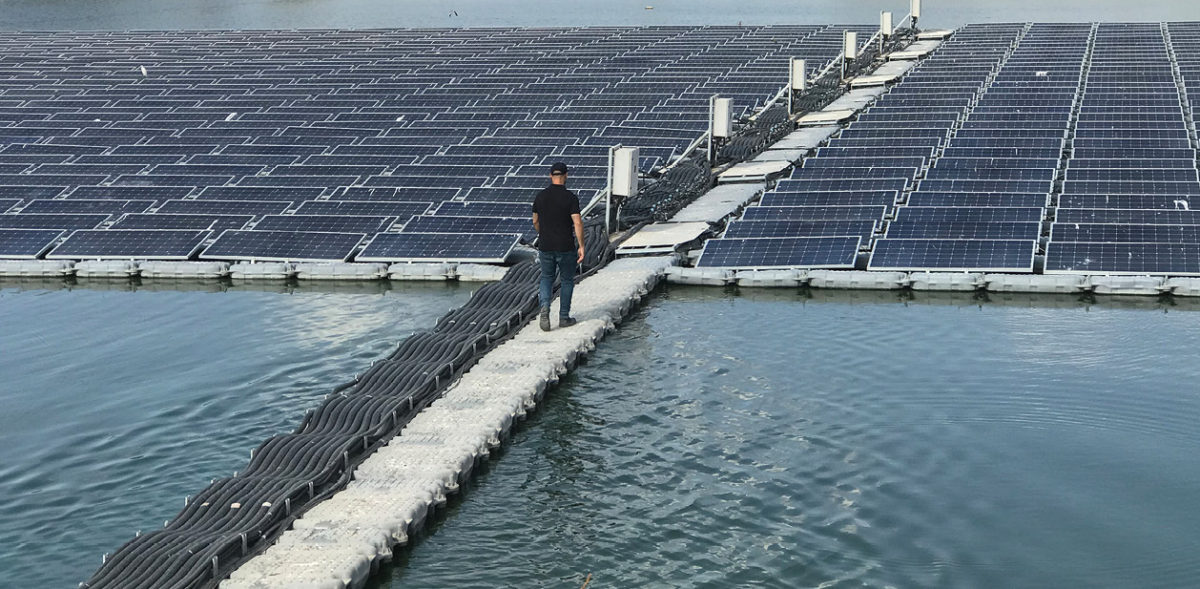https://www.pv-magazine.com/2022/12/10/weekend-read-poes-gloomy-outlook/
Weekend read: Back to the future: Israel’s faith in FITs

The opportunities for floating PV are rising in Israel, as irrigation plays a big role in its agricultural sector.
Image: pv magazine/Ilias Tsagas
From pv magazine 12/2022
Israel’s solar sector started in earnest in 2008 with the introduction of a feed-in tariff (FIT). Since then the country has embarked on several policy changes concerning the allocation and remuneration of PV. The nation runs regular tenders for utility scale solar and the rooftop segment is also catching the eye.
Israel is a small nation with land-shortage issues, but developers seeking ground-mounted project opportunities are also handicapped by the fact that most of the population is concentrated in a central belt, where prices are very high. While the government is investing in ambitious plans for agrivoltaics, agricultural and commercial activity further restricts the number of solar sites available.
Despite the lack of space, Israel has a goal of generating 30% of its electricity from renewables by 2030. And given that wind power is limited, that largely means solar. With policymakers, industry associations, and business agreeing on the need for dual-use deployment, rooftop solar offers a neat solution as part of the puzzle.
A good FIT
Whereas other nations have phased out fixed payments for solar, Israel’s rooftop FIT remains. The FIT payments have a duration of 25 years and are currently the main force supporting Israel’s rooftop PV segment. Last year, rooftop arrays with a generation capacity of up to 200 kW (AC) qualified for FITs. This year that rule changed to permit only systems up to 100 kW to bank the €0.12 ($0.12)/kWh payment, although owners of systems up to 300 kW can still receive a reduced tariff. Those sky-high property prices in the central belt also prompted a recent move to offer an additional, top-up payment of €0.014/kWh for sub-100 kW systems in such locations.
The current embrace of FITs was not always the case. In fact, the government had previously halted the FIT scheme, replacing it with a net metering program that ran from 2013 to 2018. But the government has now scrapped the net-metering program, re-introducing FITs. During its rollout, the net-metering program drove around 380 MW of largely rooftop generation capacity – although floating solar plants and at least one big ground-mounted system operated under the payment regime.
Nir Zohar, sales director at Israeli solar module cleaning company RST CleanTech, says the net metering system was attractive for factories and energy users with similar consumption profiles and high bills. For everyone else, Zohar says, FITs are better.
With the nation undergoing electricity sector reform since 2018, the popular net metering scheme fell out of favor because it was seen as distorting the market, explains Eitan Parnass, founder and director of Israel’s Green Energy Association. As part of the reforms, large electricity users will cease to pay a fixed price for power from Jan. 1, with big consumers paying higher evening prices when there is no solar energy generation.
Variable pricing will hit owners of net-metered sites who will receive lower tariffs when they are generating and have to pay more for power at other times. That could reduce income by up to 40% for such investors, says Parnass, who indicated the government is considering a compensation mechanism.
Local opportunity
The lack of net-metering, though, has failed to stem rooftop installations, as RST CleanTech CEO Roy Sade explains. He previously worked for an Israeli PV developer and says municipalities were, and continue to be, big installers of rooftop solar, thanks to the FIT. Tel Aviv municipal government’s solar rooftops, for example, earn the city around $300,000 per month, says Sade.
It was working with municipalities that gave Sade the idea to start his panel cleaning company, after an enquiry from a high school where a student had slipped on water pooling in the yard – and claimed for injury – the result of an array being cleaned with a hose. The school asked about automated cleaning systems.
With panel makers stipulating warranty requirements, modules should not be cleaned during the day when they are hot and generating power, and with high-pressure cleaning is also prohibited, Sade came up with an automated cleaning system installed on the panels.
RST CleanTech began in 2011, with a pilot system on Sade’s roof. The technology was launched in 2013 and the business now cleans more than 2.5 million panels – 2 GW of generation capacity – worldwide. Cleantech has subsidiaries in Spain, Morocco, Brazil, Chile, and California, with plans for a presence in India.
The company cleans around half of Israel’s rooftop panels, it claims its cleaning solution increases the panels’ energy generation by up to 30% and also has a thriving floating-solar cleaning operation at reservoir sites.
Wastewater channeled into reservoirs met around two-thirds of the water needs of Israel’s agriculture last year and having panels over the bodies of water reduces evaporation. RST’s system often uses reservoir water to clean panels – at low pressure and at night – before returning the liquid back to the reservoir.
Popular content
Apart from presenting a strong business case, floating PV on Israel’s water reservoirs is also thriving due to the country’s highly congested electricity grid. Reservoirs use electricity to pump water but most often there are no other electricity users near the reservoirs, hence the availability of grid space to connect floating solar, explains Sade.
Energy storage
While Israeli cleantech companies have enjoyed success in foreign markets, the nation is about 10 years behind Western peers when it comes to energy storage deployment, according to Tal Mund, CEO of Israeli storage supplier and developer BLEnergy.
That is chiefly down to weak regulation, says Mund, as well as sluggish liberalization of the electricity sector, which only started in 2018. Private investors own almost half of the nation’s generation capacity and the electric transmission system operator is state-owned, even if its management operates separately from its national parent utility.
Opening up power generation took about 15 years, says Mund, delaying the diffusion of new ideas and technology onto the market.
Mund appears hopeful, though, that change is imminent and he backs up the idea by referring to a new development plan published a few weeks ago by Noga, Israel’s transmission system operator. This strategy calls for Israel to install 10 GWh of energy storage capacity in order to reach that 2030 goal of generating 30% of electricity from renewables.
Israel’s grid is highly congested and the only way for the country to reach its target is through the widespread deployment of energy storage systems that support the grid, according to Mund. The country, however, does not have a robust energy storage framework that would enable such investment at present and the market for grid ancillary services is non-existent.
“We would like to see competitive tenders in Israel for energy storage projects located in front of the meter that would offer grid services and receive payment for the times they are available to serve the grid,” Mund tells pv magazine. He appears optimistic that such tenders are imminent and, returning to the plans announced by Noga, believes Israel could see the first tender for front-of-meter storage systems within the next six months.
Meanwhile, Israel has already tendered new solar capacity to be installed alongside four-hour, behind-the-meter battery systems. Shai Baharav, co-founder at BLEnergy, says that from these solar-plus-storage tenders, Israel is expected to install around 400 MWh of battery storage capacity in the next few months, and a total of 2.5 GWh in the next two to three years. “The implementation of these projects has been slow because there was not enough grid space to connect the PV capacity,” he says. “And perhaps some of this delay is also due to the high costs of the batteries.”
BLEnergy has signed a deal to supply the components for 200 MWh of battery storage as part of the solar-plus-storage tender and it also works on around 100 MWh of other behind-the-meter storage projects, for various types of customer such as shopping malls, factories and electric vehicle (EV) charging stations. The use of these 100 MWh worth of systems varies according to the needs of the customer but they are mostly based on the arbitrage business model of purchasing off-peak power and storing it for release at peak times for a higher return.
Blilious Group is BLEnergy’s parent company and it has entered Israel’s public transportation business. It also has a hand in the EV market and is developing a battery project to support a charging station for 60 electric buses that belong to its parent, and which received a grid connection only a few months ago.
Kibbutzim innovation
The central principle of Israel’s kibbutzim – co-operative, self-sufficient agricultural communities centered on common work and profit-sharing – fits well with the idea of “prosumer” electricity generation and consumption. Kibbutzim function as an ecosystem for Israeli innovation and, having grown in scale since their origins, many now operate their own mini-grids and generate their own electricity to be traded within their small, internal electricity markets. Many kibbutzim are RST Cleantech clients, indeed Noga’s recent development plan refers specifically to the storage systems of such communities, and BLEnergy supplied the components for Israel’s first battery system, which is installed in a kibbutz. The storage company is now working together with many kibbutzim to install more behind-the-meter battery systems.
The kibbutzim mini-grids are becoming sophisticated because their communities are eager adopters of PV and often cannot install as many solar systems as they would like because their networks are congested. As a result, they are interested in adopting energy storage solutions. “Kibbutzim also have – or try to acquire – the knowledge to run the battery systems alone,” says BLEnergy’s Baharav. “Often, they train members of their communities to do this while some choose to let firms outside their communities manage these systems separately or together with them. A few kibbutzim also unite to form common electricity entities that they run together. Our work with them is a main component of our business today.”
A decade ago Israel’s electricity market was entirely centralized and dominated by a single utility, which is to say, a monopoly. But as Baharav explains, “in the last two or three years, everybody talks about the movement from a centralized to a decentralized energy system and we are just starting to see this change materializing.”
The author traveled to Israel as a guest of RST CleanTech.
This content is protected by copyright and may not be reused. If you want to cooperate with us and would like to reuse some of our content, please contact: editors@pv-magazine.com.

![[Dans les allées d’Energaïa] PowR Group veut révolutionner le solaire en façade](http://isolarparts.com/cdn/shop/articles/powr-scaled.jpg?v=1670775980&width=1440)

